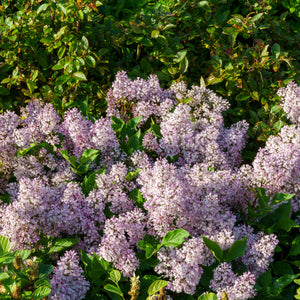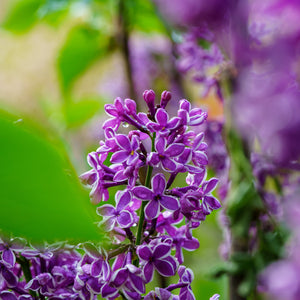The Lilac Guide
Lilacs (genus Syringa) are beloved flowering shrubs known for their fragrant spring blooms, classic upright form, and nostalgic presence in traditional and cottage-style gardens. With varieties ranging from compact dwarf selections to tree-form specimens, lilacs provide structure, seasonal beauty, and a delightful fragrance that has made them a garden favorite for centuries.
About
The Syringa genus includes approximately 20 to 25 species and hundreds of cultivars, most of which are native to eastern Europe and temperate Asia. These deciduous shrubs and small trees have been cultivated since at least the 16th century and remain among the most cherished spring-flowering plants in temperate gardens.
The most well-known species is Syringa vulgaris, or common lilac, which features large, conical flower clusters in a range of colors—lavender, purple, pink, white, and even bicolor. Its iconic scent is strong and sweet, often evoking memories of old homesteads or historic gardens.
Syringa meyeri 'Palibin', a Korean dwarf lilac, is valued for its compact size, mildew resistance, and late spring blooms. Syringa pubescens subsp. patula 'Miss Kim' offers a more rounded habit with slightly later blooms and reddish fall foliage. Tree-form species like Syringa reticulata 'Ivory Silk' bloom in early summer with creamy white flowers and are suitable for urban planting or large-scale design.
Hybrid groups such as Syringa x hyacinthiflora and Syringa x prestoniae were developed to offer increased cold hardiness, resistance to disease, and expanded bloom times. These hybrids often display intermediate characteristics between parent species and are useful in extending the lilac flowering season across multiple months.
In addition to beauty and fragrance, lilacs provide ecological value. Their nectar-rich blooms attract bees, butterflies, and other pollinators in spring. Their dense branches offer shelter for birds, and their woody stems add winter interest to the landscape.
From old-fashioned charm to modern compact selections, the diversity within the Syringa genus ensures there is a lilac suited to nearly every design style and climate.
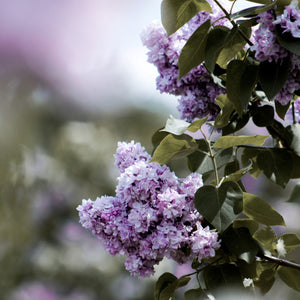
PLANTING
Lilacs thrive in sunny, open areas with good air circulation and well-drained soil. Proper siting and preparation are key to long-term success.
USDA Hardiness Zones: Most lilacs are hardy in Zones 3–7, with some selections extending into Zone 8 depending on chill hour requirements.
Soil: Well-drained, neutral to slightly alkaline soils are ideal. Avoid heavy clay or waterlogged conditions.
Sunlight: Full sun is essential for abundant flowering. Lilacs require at least 6 hours of direct sunlight daily.
Watering: Provide regular watering during establishment. Mature plants are moderately drought-tolerant but benefit from supplemental moisture in dry spells.
Spacing: Standard lilacs like Syringa vulgaris should be spaced 5 to 15 feet apart depending on variety. Compact or dwarf forms can be planted closer together.
Planting Time: Best planted in early spring or fall when temperatures are cool and roots can establish without stress.
CARE
Watering: Deeply water newly planted lilacs once a week during the first growing season. Mature plants require less frequent watering but should not be allowed to dry out completely during drought.
Fertilizing: Apply a balanced fertilizer in early spring. Avoid high-nitrogen products, which can encourage foliage growth at the expense of blooms.
Pruning: Prune immediately after flowering in late spring. Remove spent flower heads, thin out older stems at the base, and cut back any weak or overcrowded branches. Avoid summer or fall pruning, which can remove next year's flower buds.
Pests and Diseases: Lilacs are susceptible to powdery mildew, especially in humid or poorly ventilated areas. Choose resistant varieties and ensure good airflow. Other potential issues include lilac borer, scale, or bacterial blight.
Mulching: Mulch around the base with organic material to conserve moisture and suppress weeds, keeping mulch a few inches away from the trunk.
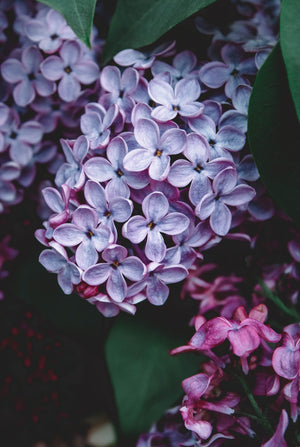
HOW TO USE
Focal Point: Larger lilacs like Syringa vulgaris ‘President Grevy’ or ‘Sensation’ make striking focal points in spring gardens, drawing the eye with their height, flower color, and fragrance. Plant as stand-alone specimens or anchor them at the corner of a foundation.
Hedges and Screens: Tall lilac cultivars work well as informal hedges or privacy screens. They provide seasonal privacy and structure while offering beautiful blooms in spring. Plant in staggered rows for fullness.
Mixed Borders: Add lilacs to sunny mixed borders alongside peonies, irises, spirea, or ornamental grasses. Their upright growth adds vertical structure and their flowering season pairs well with many perennials.
Foundation Plantings: Compact varieties like ‘Palibin’ or ‘Miss Kim’ are well-suited to foundation beds and smaller gardens. Their tidy shape and manageable size make them ideal for lower-maintenance spaces.
Cottage and Traditional Gardens: Lilacs are staples of cottage-style gardens. Combine with roses, delphiniums, or phlox to evoke a nostalgic and romantic atmosphere.
Cut Flower Gardens: Lilacs make excellent cut flowers. Plant near patios, walkways, or windows to enjoy their fragrance, and harvest blooms early in the morning for best longevity.
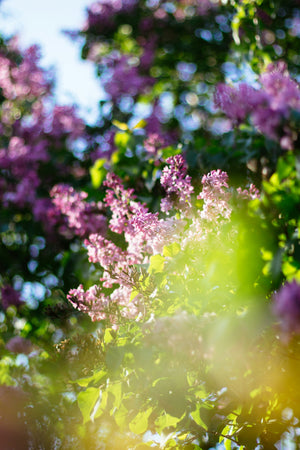
Common Questions
How to trim lilac bushes? Trim immediately after blooming in spring. Remove spent flower heads and prune stems to shape the plant or rejuvenate older growth.
When to trim lilac bushes? Late spring, directly after the flowering period, is the best time. Avoid pruning in summer or fall.
Are lilacs poisonous to cats or dogs? Lilacs are considered non-toxic to pets, though ingestion of large quantities may still cause digestive upset.
When do lilacs bloom? Most common lilacs bloom in mid to late spring. Some species, like Syringa reticulata, bloom later in early summer.
Do lilacs need pest control? Lilacs are generally low-maintenance but may require treatment for powdery mildew or lilac borers in some regions.
What is the shape of a lilac? Most lilacs have an upright, vase-like form with multiple stems and arching branches.
What is the size of a lilac? Standard lilacs can reach 8 to 15 feet tall and wide. Dwarf forms stay under 5 feet in both height and spread.
Are lilacs edible? While not commonly consumed, lilac flowers are technically edible and sometimes used to flavor syrups or desserts.
Do rabbits eat lilac? Rabbits typically avoid lilac due to its woody stems and mildly bitter taste.
Do lilacs need full sun? Yes, lilacs bloom best in full sun with at least 6 hours of direct sunlight per day.
Conclusion
Lilacs are timeless flowering shrubs that blend fragrance, form, and elegance into any sunny landscape. From towering classics to petite foundation options, there's a lilac for nearly every garden style. With minimal care and long-lasting charm, these shrubs continue to be one of the most cherished spring bloomers in the garden.
The Lilac Collection
Sold Out
Sold Out

